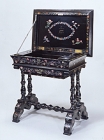Japanese Gallery (Honkan) Room 13
March 24, 2010 (Wed) - June 13, 2010 (Sun)
From the pre-modern era, Oriental taste was favored widely among the European nobility, and Japanese lacquerware was highly popular as interior decor representative of the Orient. Export lacquerware, especially created to meet the needs and tastes of Europeans, was produced in forms and designs different from those used domestically in Japan.
The export of Japanese lacquerware to Europe started at the end of the Azuchi-Momoyama period (from between the end of the 16th century and the beginning of the 17th century) with orders from Spanish and Portuguese Christian missionaries active in Japan. Later, when the Edo shogunate banished missionaries from the land and closed the nation's borders, trade between Japan and Europe was carried out by the Dutch. The account books of the Dutch East India Company show the massive amount of Japanese lacquerware purchased during these times.
Until the 20th century, many types of Japanese lacquerware travelled overseas, and this exhibition reflects how it remained sought after outside of Japan over the years.

